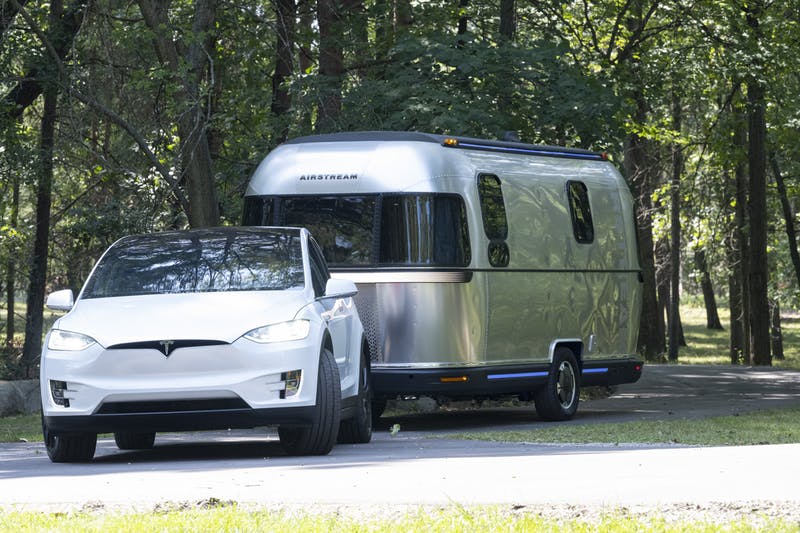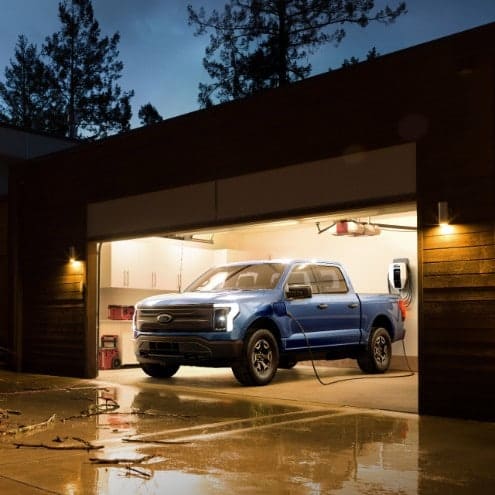If we look back on the history of the RV industry, we can see many instances of innovations that have shaped how we got to today. However, as we reflect on the past while looking forward to the future, it’s clear that we are sitting on the cusp of what may be the most significant change to the RV industry in our lifetime. The electric vehicle revolution is no longer a trend but a precursor to what lies ahead. According to a recent survey conducted by the account and consulting firm KPMG, auto executives believe that more than half of their sales will be electric vehicles by 2030. That is merely eight years away. Industry experts are also predicting that by 2040, all new vehicles sold in the U.S. will be electric.
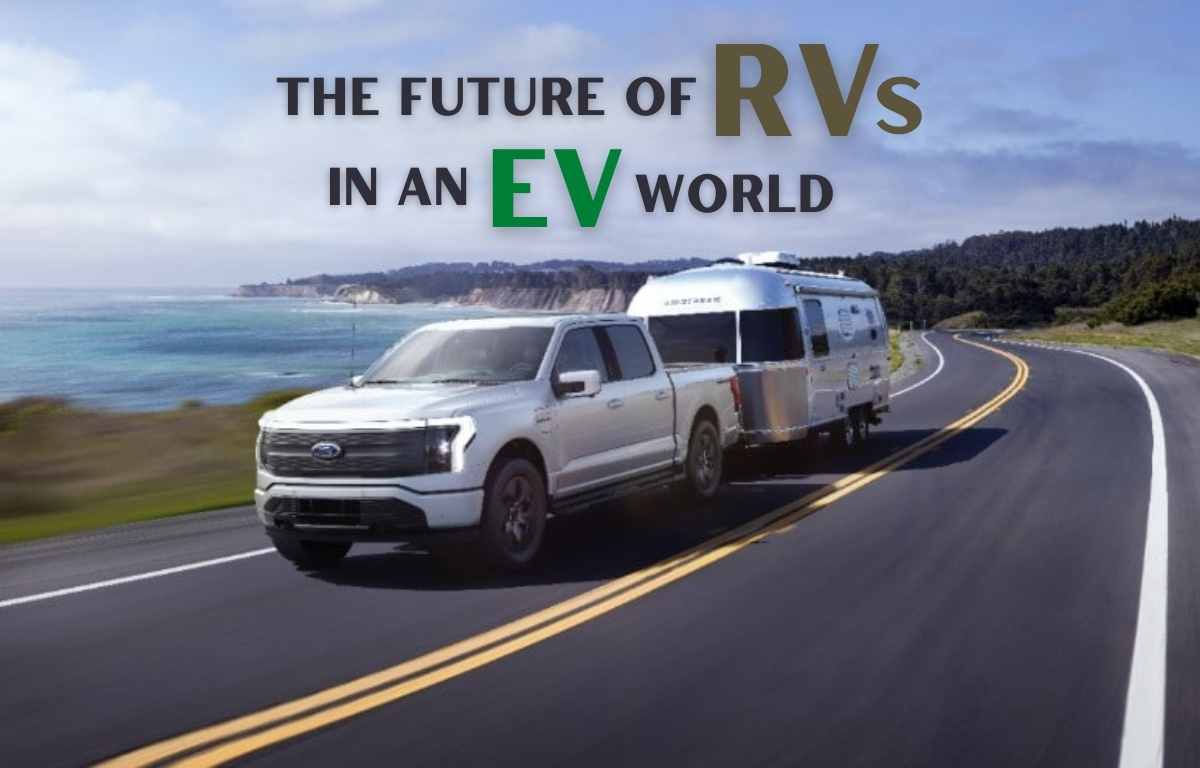
While this change in the automobile industry is mind-boggling for those of us who grew up counting cylinders and pumping fossil fuel into our vehicles, it’s something that we have been gradually preparing for over the past decade. The electric vehicle (EV) revolution is transitioning from a niche market and heading mainstream.
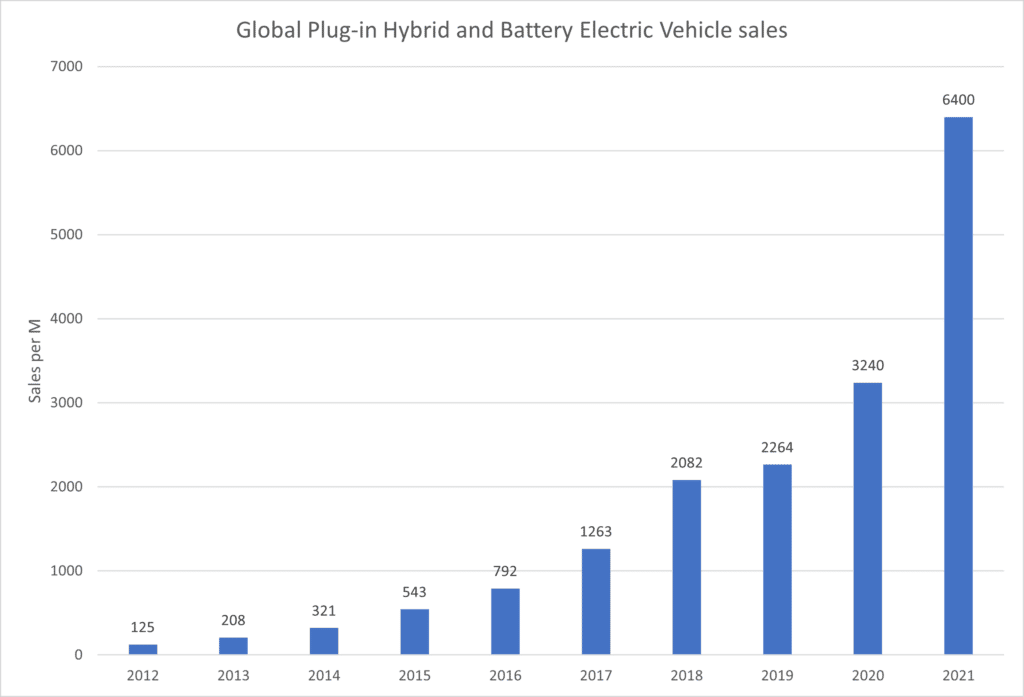
For most applications, aside from getting used to plugging in vs. fueling up, the majority of drivers will adapt. Sure, there will be holdouts of motorheads mourning the loss of combustion, but just like every other technological trend, society will adjust to its new reality. As a result, by 2030, half of you reading this article may very well be driving an EV.
However, for those of us who fall outside of the standard driver classification and tow around 12,000 lb. living quarters, does the EV market have a plan for us? Unfortunately, we’re only starting to see the first electric trucks hit the market, and right now, they’re not ready for the entire RV industry.
EV technology needs to improve before we see capable solutions for the traditional RV community. This change will come in time, but for it to become a viable option for RVers, other segments of the RV industry must innovate as well. EV trucks alone won’t provide a viable option for fossil-fuel RV travel.
The primary issue with EV trucks and RV towing is distance and battery life. Existing technology is available to build a capable truck that can haul heavy loads, even the heaviest fifth-wheel trailer. However, the limitations emerge when it comes to reliably towing heavy loads for long distances, which the RV community needs.
While putting these concerns aside, it’s exciting to see EV trucks hit the market. Over the next three years, EV alternatives for tow vehicles will be much more accessible as more manufacturers send their prototypes into production. Two of the first EV trucks to come to the market, the Rivian R1T and Ford F150 Lightning, offer some promising hope. While they’re not perfect for the needs of the RV community, they are paving the way for future advancements.
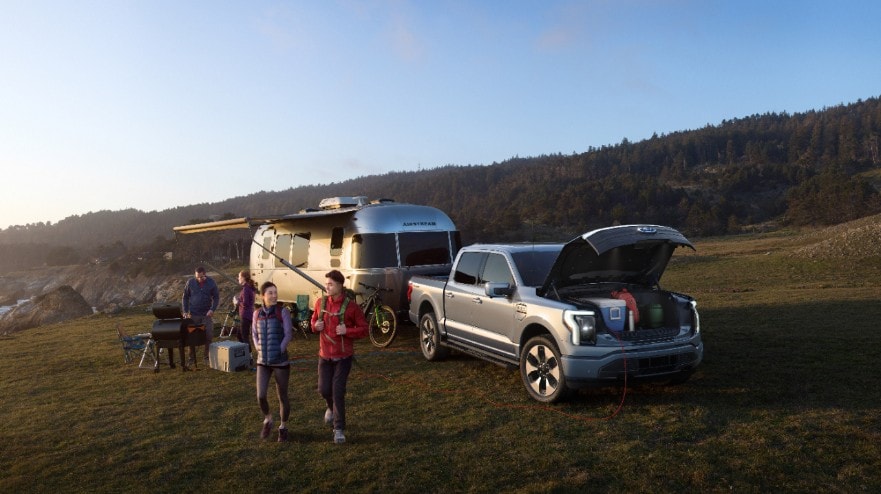
What EV trucks lack in battery capacity and range, they make up for in power and torque. For example, the new Ford F150 Lightning delivers 426 horsepower. Both the long-range and standard batteries deliver 775 lb-ft of torque, which is 205 more lb-ft than the newest gas-powered motor, the PowerBoost hybrid V6.
A fully equipped Ford Lightning with the extended range battery pack can tow loads up to 10,000-pounds. It also has a 1,800 lb. payload capacity. That doesn’t appear too bad on paper for moderately sized travel trailers. However, capacity is only half of the battle. If towing at full capacity, the Ford Lightning may be hard-pressed to exceed 100 miles in range.
Things don’t look much better for Ford’s rival, the Rivian R1T. With a slightly higher tow rating of 11,000 lbs, the R1T offers attractive tow capabilities. However, like the Ford Lightning, the limitations come down to its range. Rivian warns that the range might be cut by roughly 50% when towing, taking its 314-mile range down to 157 miles. This distance is under ideal conditions, so real-world results will likely be closer to 100-120 miles.
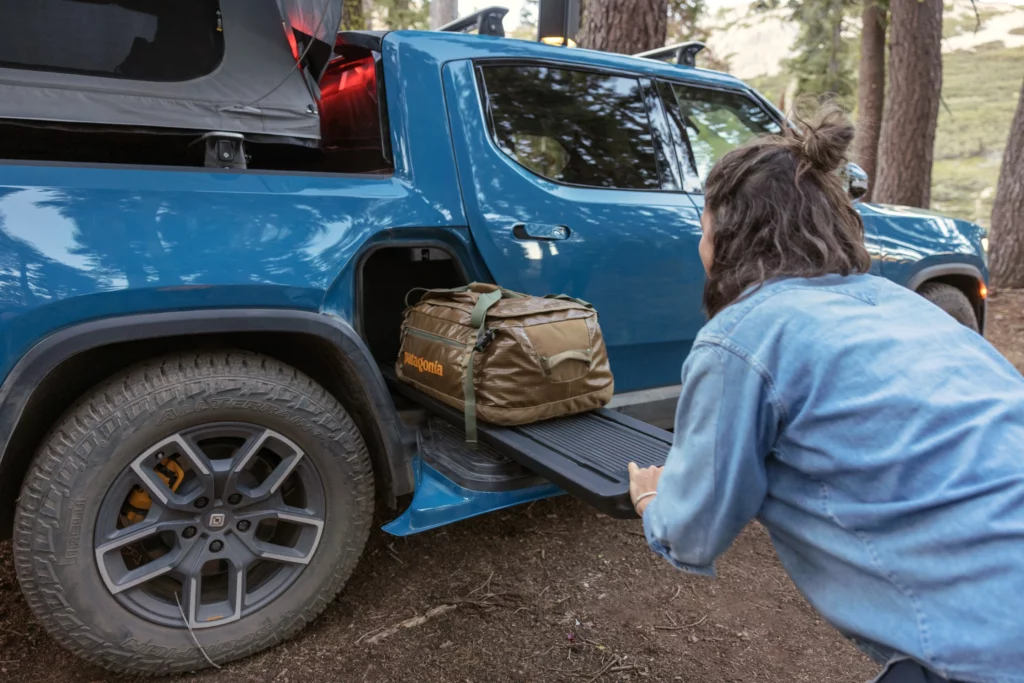
The limitation of both these trucks won’t be overcome when the competition releases their initial EV trucks. Rival truck manufacturers such as Chevrolet, GM, Tesla, and others will offer similar capabilities when they first dip their tow into the EV truck market. The biggest hurdle for the industry is balancing battery capacity, weight, cost, and charging times.
The heavy-duty lithium-ion batteries needed to power a truck’s drivetrain are a significant portion of the manufacturing cost. This drives up the cost of new electric trucks compared to similar, gas-powered vehicles. Adding range and tow capacity is less about the engine size and more about the battery capacity. To solve this challenge, trucks simply need more batteries. However, more batteries mean more weight, higher costs, and significantly longer and unrealistic charging times.
Batteries
The technology that has allowed the EV market to grow to widespread adoption is also its Achilles heel. Battery technology has advanced to a point where price and capacity have provided the green light for auto manufacturers to hedge their future on the EV market. However, current battery technology can only take us so far. Most manufacturers have relied on the same battery technology for more than a decade- Lithion Ion batteries. The main change that has accelerated their adoption has been affordability.

However, powering the EV fleet of the future will take more than just more affordable batteries. Innovation is needed to develop new battery technology that provides more capacity, lighter weights, faster charging, at a low price point. That’s a heavy ask of the battery industry, but billions of dollars are being invested to achieve just this.
Lithium-ion batteries are the current technology of the present but won’t be of the future. Their popularity is due to several key factors. They offer a long lifespan, currently between 10 to 20 years. They also have a high power-to-weight ratio and are energy efficient. One significant green benefit is that they’re also recyclable, although material recovery must overcome several hurdles. Most importantly, for manufacturers, is they’re becoming more affordable. Lithium-Ion batteries dropped by more than 85% in costs since 2008.
Although lithium-ion batteries remain the prevailing technology of the EV industry, engineers have been working feverishly to develop new technology to replace them. The most promising advancement will be solid-state batteries. Solid-state batteries will transform the battery and EV industries, significantly reducing the size of batteries, enhancing safety, and increasing efficiency and charging times. They’ll also have a longer lifespan.
Solid-state cells inherit a lot of their technology from their lithium-ion counterparts. They both store and discharge energy as conventional cells. The difference comes from how they move the lithium-ion around. Conventional batteries use a liquid-based electrolyte, while solid-state batteries substitute this with very thin solid electrolytes made from more stable materials like ceramic, polymer, or glass.
The current downside with solid-state batteries is that the technology is just not ready. To date, no company has demonstrated the ability to manufacture solid-state cells for mass production. Dozens of high-profile projects are still in the testing stage. However, it’s less likely a question of if they will get to the market, but rather when they will. Even though many countries plan to phase out internal combustion engines (ICE) by 2030 and the U.S. shortly afterward, most industry experts believe that we’re still eight or more years away from vehicle-ready solutions powered by solid-state batteries. However, it will happen, but the EV market will have to grow with current technology until it does.
Charging stations
Batteries are just one component of the RV industry’s challenges for the EV revolution. Another is charging on the road. While the last decade has resulted in significant growth of EV charging stations, they are designed for the passenger vehicle market. Trucks towing RVs simply can’t utilize the current charging options. Also, since towing RVs with current technology will require more frequent stops, RVers will need a lot of these larger stations. RVs will take up a lot of space when parked to charge, perhaps the room of 4-5 passenger vehicles. They may also take longer to charge with their larger battery banks.
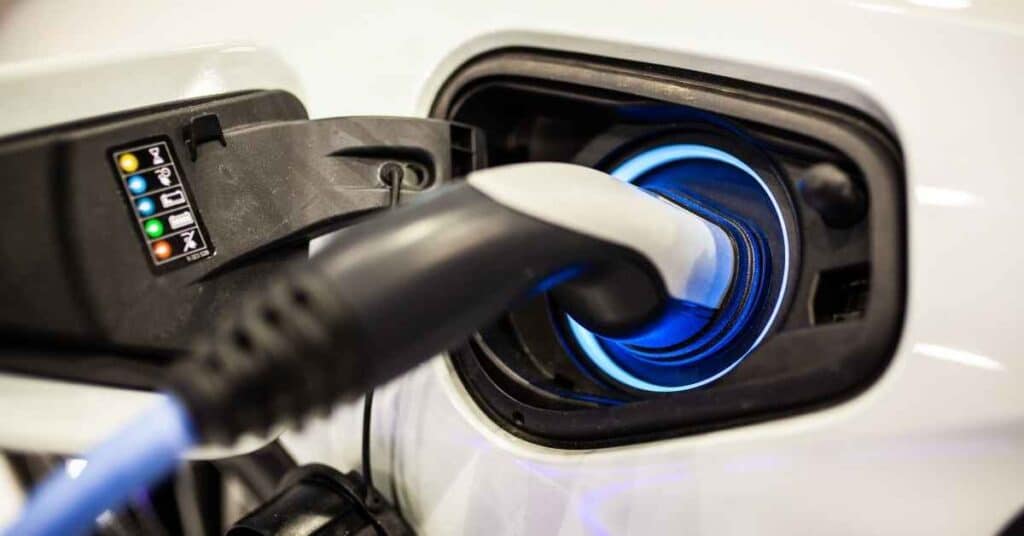
The current reality is that there just aren’t any mainstream options available to accommodate this right now. However, EV technology will eventually make its way into the hauling and transportation sector. When this happens, the need for charging for electric semi-trucks transporting goods and materials across the country may lead to solutions for the RV community.
RV design and size
Until EV technology significantly improves, most of the RV fleet on the road today won’t be able to take advantage of it. This reality is simply due to the fact that many RVs are big and heavy. Trucks like the Ford Lightning or Rivian R1T cannot tow the larger trailers and 5th wheels on the road today. Even the ones within their tow capacities won’t be viable options because of the truck’s limited range when towing.
RV design is simply not ready for the EV market. Getting there will require innovation and the adoption of new, lighter materials and more aerodynamic designs. The only viable RVs ready for the EV truck market today are the small teardrop-shaped RVs or slightly larger ones used by weekend warriors camping close to home. RVers accustomed to larger RV living quarters, fifth wheels, and long-distance travel will not have viable options for several years.
Campgrounds
Another challenge for electric RVing is the traveler’s end destination: the campground. Can campgrounds handle the electric demand of an electric RV fleet? Currently, the answer to this is no. Many campgrounds are maxed-out with their electrical capacity. Many campgrounds operate using a private electric network installed in the 1970s and 1980s. If you’ve camped at any older park, you will know that power outages are pretty common on hot summer days when dozens of RVs are running their air conditioners. Now, complicate this electric demand with EV charging, and many campgrounds simply won’t be able to keep up with it.
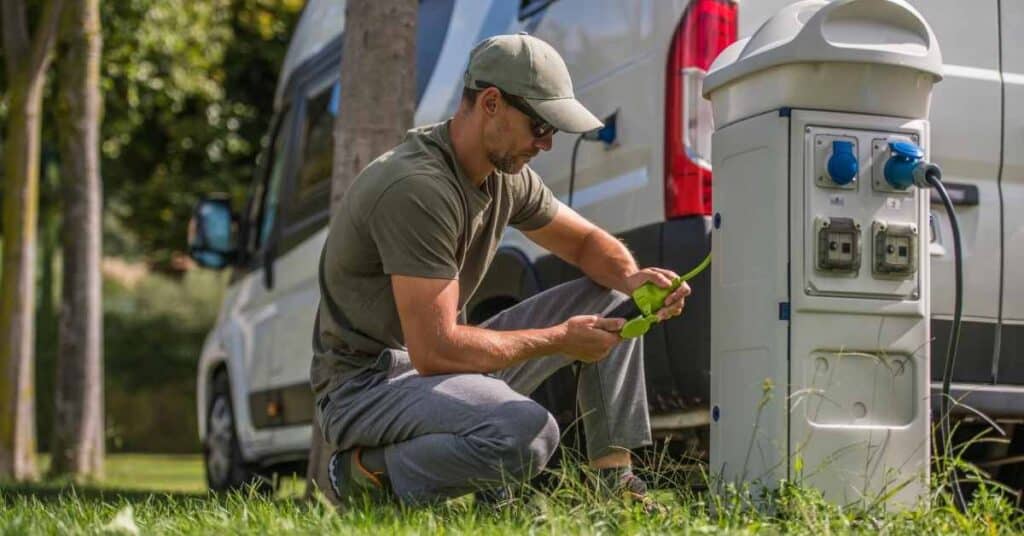
This issue may not be a problem in the short term, but campgrounds will need to prepare and upgrade their sites for widespread EV tow vehicle use in the future. This change will take time, but more importantly, money. I venture to guess that this isn’t even on the radar of most RV park managers.
Where do we go from here?
At the beginning of the article, I suggested that we could be on the cust of one of the most significant innovation points to the RV industry. However, when reading through the challenges the industry is facing, is that accurate? The answer is yes. The reality is that there is no stopping the transition from ICEs to EVs. It’s going to happen, and the industries that rely on it must change too.
For the RV and camping industries to get ready for this change, they must work in unison with other sectors of the economy to solve the outstanding challenges. However, just as the EV truck market can’t solve everything alone, neither can the RV industry. Below are some of the critical changes we need to see in the coming years or decades to make EV RVing a reality.
Tow vehicle manufacturers and Charging
The recent introduction of EV trucks to the market is a good start. The big players in the market (Ford, GM, Chevy) have a strong history of building heavy-duty trucks to meet their customer’s needs. Even though current EV technology is not ready for this segment of their business, I can assure you that their engineers are hard at work readying themselves for this. In addition, while the RV community makes up a significant percentage of their customer base, they’re also concerned about the construction industry and fleet vehicles.
Truck manufacturers will need to invest heavily in technology that will significantly increase range and decrease weight. They will also need to lead the way in developing develop charging options for their vehicles when on the road. Elon Musk made this a priority early on when developing Tesla. As a result, while they were building cars, they were simultaneously constructing charging stations throughout the country. Other manufacturers will need to do the same and help build the necessary infrastructure to power their vehicles.
The U.S. government will also need to step in and provide funding for the electric charging infrastructure required for the EV revolution. While RVs will benefit from it, the primary driver for action will likely be the transportation industry. Moving goods and materials across the country is vital to the U.S. economy, which should push the feds into action. Transitioning the traditional diesel trucking fleet to electric alternatives will positively impact the RV community. It will provide charging options to accommodate larger rigs and in more places throughout the country.
There is some good news on the charging front. In Oregon, through a partnership by Portland General Electric and Daimler Trucks, inroads have been made in meeting the needs of big-rig charging. As it’s named, Electric Island is the first US charging station for electric semis, providing megawatt fast-charging, something that the RV industry may need. However, this technology will need to be replicated throughout the country before EV RVing can become a reality.
The advancement of electric semi-trucks is also critical for the RV industry. While towable RVs will rely on EV trucks, larger Class A motorhomes will require a whole different solution. Future EV motorhomes will likely use the same technology that powers semi-trucks and busses.
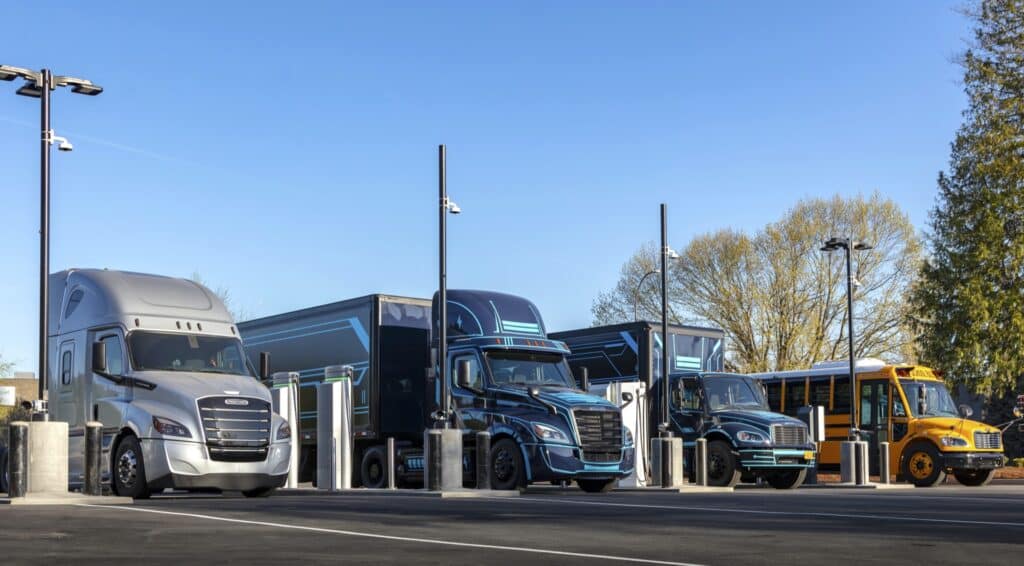
RV Design and Innovation
One of the best ways to combat the towing limitations of EV trucks is to build lighter and more aerodynamic RVs. The traditional rectangular boxes that the RV community currently hauls around simply won’t work in an EV-only market. So over the next decade, we’ll need to see newer designs that offer lighter weights while not compromising livable space.
RVs of the future will also need to work more seamlessly with the tow vehicle. One challenge with truck battery capacity is simply space. Until battery technology allows for smaller cells, space will be one of the constraining factors. RVs, however, can provide that space. For example, an extra battery bank, necessary for a longer range, can be integrated directly into the RV. This design can give the tow vehicle the extra travel distance needed by the RVer. As an added benefit, the electric components allowing this can supply the electric needs of the RV. This type of collaboration is something that we need to see.
In 2020, Camping World and Lordstown Motors, an EV truck manufacturer, announced a partnership to build an integrated electric RV/Truck. As of 2021, it appears that this partnership may not come to fruition; however, the concept is sound. RV manufacturers must work in unison with truck manufacturers to innovate and develop creative solutions.
Another exciting concept has been introduced by THOR industry’s Airstream, called eSteam. The idea centers around an RV with an integrated electric powertrain. The eStream features a high-voltage, electric drivetrain, which powers the trailer’s wheels and thus reduces the tow vehicle’s fuel or energy consumption. The electric drivetrain can also remotely park the RV without the tow vehicle – eliminating the need to back into a campsite. The battery pack also makes it an excellent off-grid vehicle.
However, the eStream concept is not the first of its kind. Across the pond in Germany, the caravan maker Dethleff has been working for nearly five years on an electric-drivetrain towable RV. In 2021, its e.home Coco underwent testing, hauling it across the Alps on a single charge towed by an electric vehicle (a passenger vehicle). These innovations will get us to a place where EV technology can work for RVers. We need to see more of them.
EV-ready Campgrounds
As mentioned above, one of the challenges for the future EV Rving experience is the needed upgrades to the campground electrical infrastructure. Outdated and insufficient electrical connections at RV parks will undoubtedly run into problems when dozens of RVs and trucks power up. As a result, campgrounds will need to upgrade their sites, but RVs will also need to become more self-sufficient.
Just as RVs indeed to ntegrate with tow vehicles, they will also need to integrate with campground electrical connections. Larger onboard batteries on both trucks and within RVs will need to serve as power-hubs. As a result, the campground’s electricity demand can be offset with power supplied directly from the rig. If RVs are built to be more self-sufficient, they can learn to sip electricity from the grid rather than chug it at high-demand times.
Powering a vehicle is much more demanding than powering an RV when parked. One of the future goals of EVs is to serve as a generator replacement for homes. For example, when equipped with an extended range battery, the Ford Lightning can power an entire house, for three whole days, based on household usage of 30 kilowatt-hours. Ford says that the battery can stretch for even ten days when rationing usage. Applying this same technology to an RV can theoretically meet the electricity demand of campers for days on end.
However, accomplishing this means that RV and truck batteries must be big enough to get you to the campground and supply you with electricity while you’re there. They also must be designed to recharge efficiently. RV and EV trucks must integrate smart charging, balancing use, and recharge needs when connected to the grid.
Final thoughts
As the world moves towards a fully electric vehicle fleet, the industries that rely on them will need to adapt. Technology is advancing at lightning speed and will continue to do so in years to come. The RV industry must innovate to be ready for this certain future. However, they can’t do this alone. We need to see collaboration across the board from the auto industry, RV community, transportation industry, and federal, state, and local governments.
No single entity can solve the many challenges ahead. It’s going to take collaboration. The RV industry can’t simply wait for EV truck technology to advance, just as truck manufacturers can’t assume RVers will simply adapt to smaller RVs. Innovation must happen in unison and with intention. When it does, we’ll have a whole new camping experience. We are sitting on the cusp of change, and years from now, we’ll look back in amazement at how far we’ve come.
To learn more about electric vehicles, check out this article: https://www.saveonenergy.com/ev/

